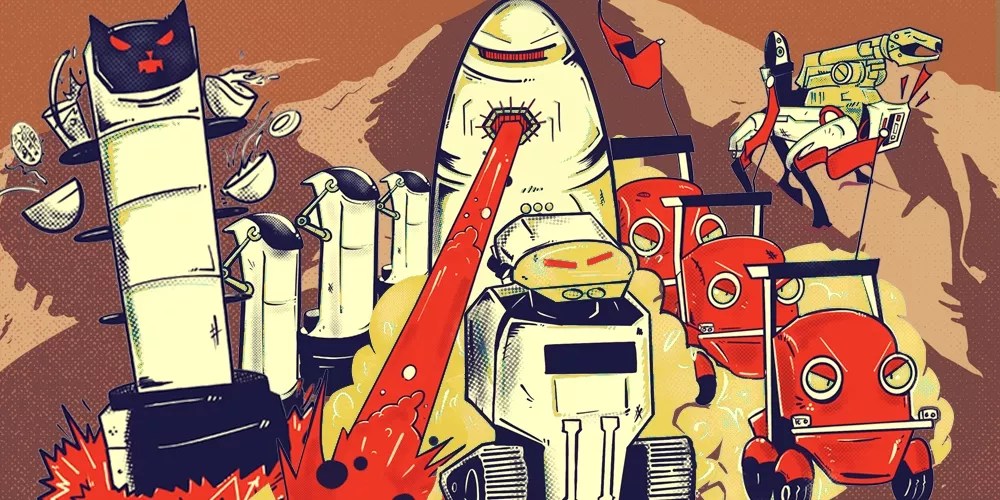
Christopher Martinez

Audio By Carbonatix
On a recent Wednesday night, a battle of man versus machine plays out near Tempe Town Lake. On one side: three dudebros in their early 20s. On the other: a pair of 3-foot-tall black-and-white Dax security robots. The robots sternly inform the men they’re trespassing on the IDEA Tempe Campus after the trio rode their Onewheels onto the property.
In the middle is Adam Pioth, playing the role of peacekeeper. He’s talking the guys down and trying to prevent them from punting either bot’s plastic head. “Just don’t kick their heads,” Pioth says.
He’s successful. The tense moment is defused. Minutes later, everyone is all smiles, including the robots.
These particular security automata are known as Dax robots – stout little machines with treaded wheels, googly digital eyes and a charming, kid-movie vibe that makes them look like they rolled straight out of a Pixar film. According to their maker – Oregon robotics company Daxbot – they’ve even been mistaken for the offspring of EVE and WALL-E. (Totally unintentional, the company swears.)
This year, make your gift count –
Invest in local news that matters.
Our work is funded by readers like you who make voluntary gifts because they value our work and want to see it continue. Make a contribution today to help us reach our $30,000 goal!
Play nice, and their eyes turn into hearts or smiles. Trespass on the property they’re monitoring, and they’ll fire off a firm warning – though it’s hard to take too seriously coming from bots this cute. A trio of Dax robots have been patrolling the IDEA Tempe Campus since earlier this year, when they were brought in by Phoenix-based Transcend Security Solutions through a partnership with Daxbot.
Pioth, a Tempe resident and founder of the local cannabis social group AZ Smoking Team, has a soft spot for the ‘bots.
“I got this weird empathy for robots,” Pioth says. “It’s like with a dog or certain animals. If I saw someone kicking a dog, I’d stop ’em. I used to joke around, but I could probably fall in love with a robot. It’s weird to even say that, but not now.”
Since discovering the Dax robots in February, he’s visited the property dozens of times to interact with his bot buddies. He’s also posted 20 Instagram videos of their interactions – two of which went viral, racking up a combined 9 million views. In one, Pioth smokes pot in front of the bot; in the other, he playfully hides from its view and places a sticker on its chassis.
Pioth says his robot fascination developed in recent years, coinciding with the rise of service bots and autonomous vehicles that have emerged in the Valley.
“I’ve always been obsessed with self-driving cars and stuff like that,” Pioth says. “It’s pretty cool, right? Sounds pretty neat – like, whoa, the future is now.”
As Pioth walks away from the IDEA Tempe Campus, his day takes a sudden turn. Two Tempe cops roll up and question him. Someone has accused him of damaging the Dax robots and trespassing on the property, which is owned by the Boyer Company, a Phoenix commercial real estate developer. The police tell him not to return.
“I’ve never damaged them ever. If anything, I’ve stopped violence against it,” Pioth later tells Phoenix New Times. “Yeah, I blew smoke at it, but it’s a robot. It doesn’t have lungs.”
Pioth is heartbroken but defiant. Like a newly divorced dad determined to see his robo-kids, he plans to stick to a nearby public walking path alongside Tempe Town Lake and the campus.
“I can record on the sidewalk, so I will be back,” he says. “Or there are more out there. I can build a bond with another robot.”
He’s got plenty to choose from. Metro Phoenix is becoming home to more service robots, driverless vehicles and other automata than in years past. Sky Harbor Airport is the first in the world where an automated car can pick you up curbside. Arizona State University’s Tempe campus is a testing ground for delivery bots – and has the medical bills to prove it. And if you squint, you might see a drone buzzing up to your porch to drop off your latest impulse buy.
If you haven’t bonded with a robot yet, just wait. They’re coming to make your acquaintance.
Rise of the robots
Companies like Waymo, Amazon and DoorDash are using local streets, sidewalks and skies to test their services and tech. Bots are bringing us food at restaurants or with delivery drones. Robo-mops are cleaning up after us while security droids like Dax are monitoring properties.
Steve Kane, a service robot consultant with Pringle Robotics in Chandler, says awareness in the cleaning and waiter bots sold by the company has “more than doubled” in the past two years.
“Our phones have been ringing constantly and it feels like we’re in an upswing,” he says. “There’s been a 40% to 50% increase in (interest from) restaurants. Not all of them are buying, but they’re interested.”
Why, fellow carbon-based lifeforms, has the Valley become a robo-haven? Heni Amor, an associate professor with ASU’s School of Computing and Augmented Intelligence, says favorable weather and other incentives have enticed companies to use the Valley as a robot lab.
“Phoenix has started to be known as an optimal place to run pilot (programs) where you try out autonomous robots,” Amor says. “One of the main reasons for the initial success with autonomous driving was the weather here and basically the urban planning here with everything on a grid.”
Local laws and politics have played a role too, he adds – including a 2018 bill introduced by then-State Rep. Kelly Townsend that granted autonomous robots the same rights as pedestrians.
“That sort of incentivized these companies to come here, and it really mostly started with Waymo coming to Phoenix,” Amor says.
In turn, Waymo, the autonomous ridesharing service that launched its pilot program in Phoenix in 2022, has been a game-changer for service robots here, along with Starship Technologies’ food-delivery drones, which arrived at ASU in 2020.
“Their success here speaks to (other tech) companies, and that’s a really good thing for Arizona,” Amor says. “It shows we’re leading the world in adopting robotics. People from all over the world come here to try out things like Waymo cars and Starship food-delivery robots.”
As you’re ferried home from the bar in a driverless robot car or receiving your lemon pepper wings via delivery bots, you may wonder: Are robots coming for your job?
The short answer is: Maybe.
Money can drive robot adoption, Kane says. Financial uncertainty, rising inflation and labor shortages following the pandemic all have fueled moves to bring robots up to speed.
“That’s what we’re seeing in some of the robotics being (bought) in the U.S.: Bottom line-centric thinking where can we save money,” he says.
Kane adds that robots are ultimately doing mainly menial work. That could mean fewer human workers in certain roles.
“Robots do the three Ds: the dirty, the dangerous and the dull jobs,” he says. “Even with my robots, we need humans to fix it, maintain it, to clean it, to update it. Even the serving robot you see, you need someone to put the food on it. I need someone to charge it. I need someone to replace the wheels. If it comes down to it, if you have a company with 100 people, technically I’m probably getting rid of your worst part-time employees. But, no, I’m not reinventing the workflow.”
Amor says such fears are a natural reaction to robots.
“It’s sort of the fears of the population,” Amor says. “These cars will take over already crowded streets or reduce the number of Uber drivers. But again, here in Arizona, I think so far the perception has been mostly a positive one that these services are not yet to a point where they are invading or really providing major risks.”

A BellaBoT used at Mesa’s Sizzling House restaurant.
Mike Madriaga
The future is now
Amor says many of the service robots that have emerged in the Valley in recent years are of a cute or personable nature to help be embraced more easily by users. “They want them to be accepted,” he says.”
When you summon a Waymo, you’re actually stepping into a white Jaguar I-PACE tricked out with tech. You feel like a sleek, cool future includes you.
The success of these early forays into Valley robot tech portends more ahead, Amor says.
“There’s major investment in the area, and ASU has become a hub attracting more companies,” he says. “What started with just Waymo and Uber has grown to include eight or nine types of service robots on streets, in restaurants and delivering packages. If that trend continues, we’ll be seeing
a lot more of them around.”
The future is now. If you’re in the Valley, you have perhaps the best chance of anyone in the hemisphere to encounter a robot on your daily rounds. Here are the robots you’re likely to find in the wild.
Cleaning robots
Custodial robots are already hard at work all over the Valley – you’re just not likely to catch them in action. Devices like the CC1 – a mobile sweeping, scrubbing, vacuuming and mopping bot made by China-based Pudu Robotics – typically do their dirty work after hours or out of sight in warehouses and industrial buildings. So while they’re definitely on the job, they’re keeping a low profile – and a shiny floor.
“It’s kind of like those Roombas you have at home,” Kane says. “Our robots are just a little more sophisticated and can do an entire building, warehouse or apartment complex. They dump the water. They fill themselves.”
They’re also dealing with the mess you left at the park.
“Cleaning robots are sweeping up pickleball courts now,” Kane says. “But again, these are during overnights. You go there (during the day), it will just be sitting in a corner.”
Kane says the growing use of robots in custodial work is due to companies dealing with staffing issues and labor shortages. He says some jobs may be lost, but sees an opportunity for humans to better themselves.
“Humans are smarter than pushing brooms and mops and riding floor scrubbers,” Kane says. He doesn’t expect robots to fully supplant human cleaners, though.
“It’s hard to predict because everything is constantly changing. But this world is built for humans,” Kane says. “There’s a lot of stairs and robots can’t go upstairs smoothly unless it’s one of those four-legged things.”
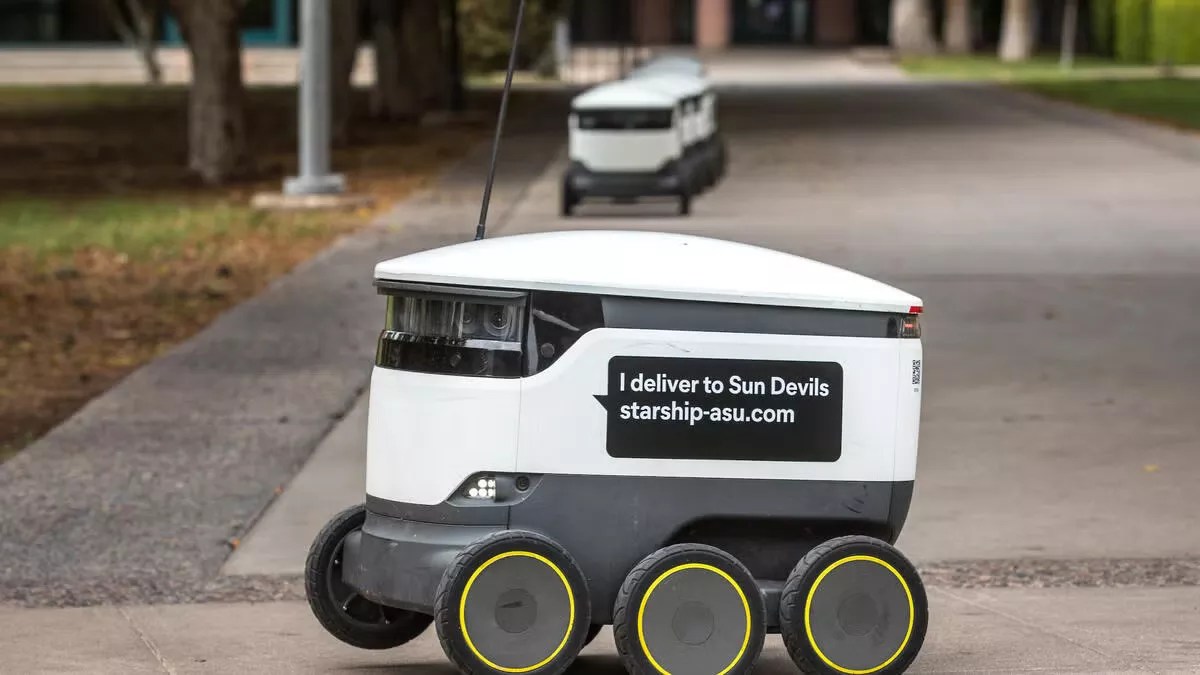
A Starship Technologies autonomous food delivery robot on ASU’s Tempe campus.
Charlie Leight/ASU Now
Starship Technologies food-delivery robots
During the darkest days of the pandemic, Arizona State University’s Tempe campus was invaded by robots. In 2020, a fleet of 40 autonomous food-delivery drones from San Francisco’s Starship Technologies began bringing meals from on-campus eateries straight to students’ doorsteps.
The six-wheeled robots quickly became a campus favorite. They made social distancing easier during peak COVID, they were convenient and they brought a dose of whimsy to pandemic doldrums. The
microbus-shaped bots were downright adorable. That charm, says Amor, helped the campus warm to them.
“They look like little Volkswagens,” he says. “Most of the time when I’ve seen people interact with them, they think they’re cute.”
Until they weren’t. In 2024, a Starship robot suddenly reversed outside a campus parking garage and collided with an ASU employee, sending her to the ground and causing a 4-inch cut on her arm and lower back trauma, before attempting to hit her again. The company reached out to provide insurance info and promo codes (because nothing says “sorry” like a free sandwich). They later told the media the robot had detected an oncoming vehicle.

A BellaBoT at Thai Recipe Bistro in central Phoenix.
Benjamin Leatherman
BellaBoT
The internet loves cats – always has, always will. So it’s no surprise this feline-inspired restaurant droid manufactured by China’s Pudu Robotics started popping up on social media after debuting at Valley eateries in recent years.
With its kawaii-style animated face, purring sounds and the unshakable confidence of a cat that owns the room, the BellaBoT brings the charm. Patrons can even scratch behind its ears to trigger a positive reaction from the bot.
Described as a “Roomba with shelves,” the column-shaped robot cruises around local spots delivering plates at eateries including Thai Recipe Bistro, and all three Kura Revolving Sushi Bar locations.
Kane says it’s best suited for fast-casual restaurants or businesses dealing with staff shortages, but that hasn’t stopped local bar owners from wanting one just for the novelty.
“Some of the bars were like, ‘Bring one over to my place for St. Patrick’s Day, we’ll trick it out in all this green stuff.’ It’s not really for that,” Kane says. “It’s for the days when (employees) don’t show up, and they need this thing to send out food and come back. If you’re already killing it with big crowds, you don’t need a robotic server. It can’t really get around all those people.”
KettyBoT
Pudu’s KettyBoT is basically a rolling billboard with a side hustle as a restaurant and event host. The tall automaton is equipped with a giant touchscreen that can display ads or greetings, or just silently judge your formalwear choices. “It’s more of a hosting (bot). You follow it to your table, it spins around, you get the silverware and it goes back to the hostess stand,” Kane says. “It couldn’t even deliver food to a four-top.”
You can also spot it at more upscale establishments around town, and it serves the upwardly mobile at high-falutin fundraisers and soirees.
“When there’s big events in ballrooms, we bring it,” Kane says. “We had it at a fundraiser with the ALS (Foundation) in Scottsdale filled with waters and beers and ran around the lobby the whole night.”
Amazon Prime Air drones
At this point, if a human can do it, Amazon’s figuring out how a robot can do it faster – and without needing a piss bottle. The company’s fulfillment centers, including all 17 in Arizona, buzz with bots that assist with sorting, lifting and moving packages. And as of last month, Amazon’s Prime Air drones are back in action, hauling parcels and late-night impulse buys across the West Valley skies.
In January, its autonomous MK30 fleet was briefly grounded due to a few crashes and technical hiccups, but are again zipping around a 7-mile radius of the Tolleson fulfillment center. Picture futuristic carrier pigeons – only with GPS, spinning rotors and a talent for dropping dog food weighing 5 pounds or less on your porch in under 30 minutes.
Not everyone’s sold on the service. As one West Valley resident told KTVK-TV Channel 3 earlier this year, “What if it hit a cat or a pet, or even landed on your car? It could be dangerous.” Fair point.
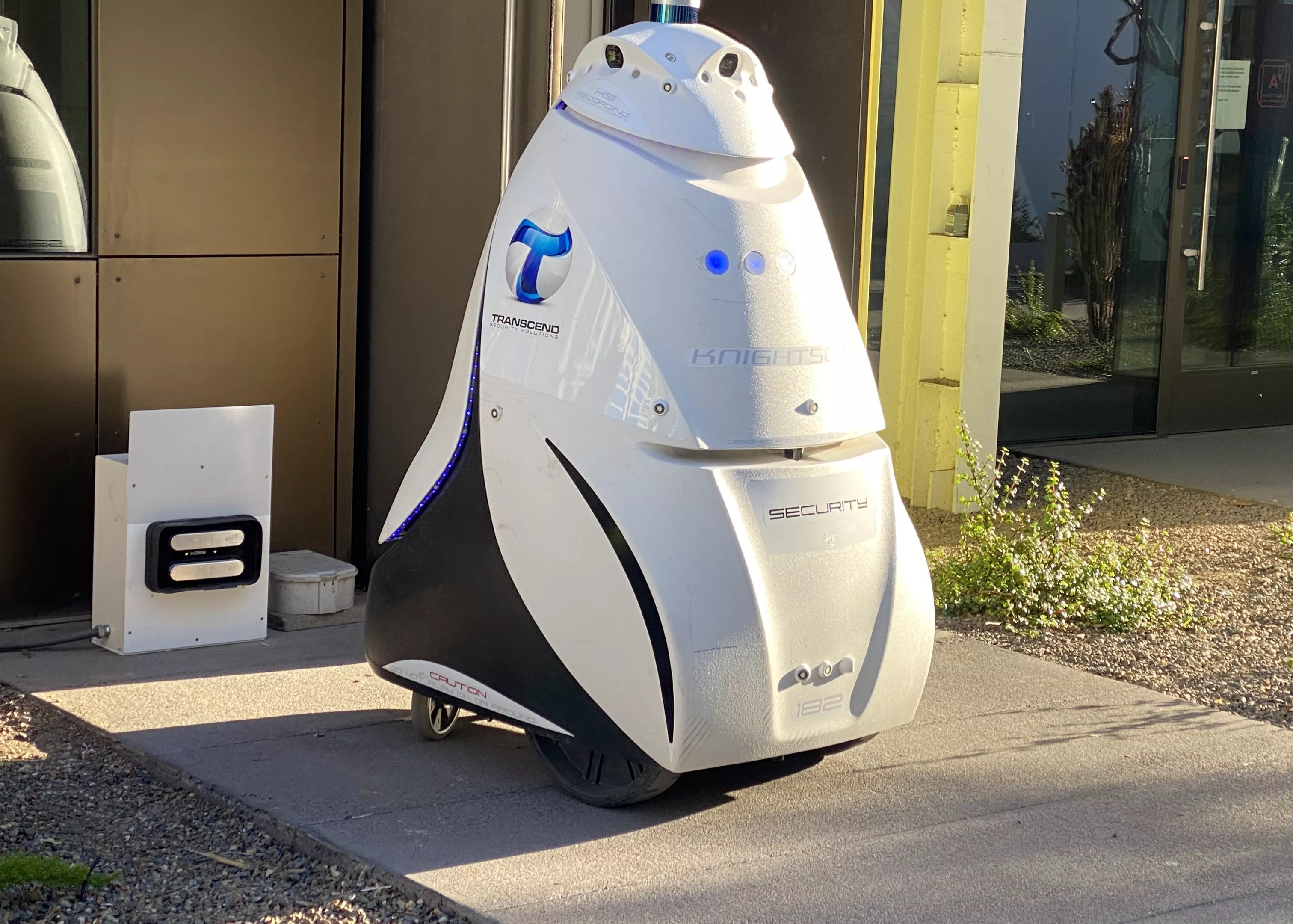
A Knightscope security robot at Park Central in Phoenix.
Benjamin Leatherman
Parker
Don’t let its resemblance to an oversized sex toy fool you. Parker, the Knightscope K5 Autonomous Security Robot, is all business. Standing around 5-foot-5 and clocking in at 420 pounds, this glossy white automaton roams Park Central with purpose. Armed with cameras, thermal imaging, sonar, lidar, license plate recognition and other surveillance gear, Parker maintains ’round-the-clock vigilance of the sprawling property.
First introduced in 2021 by Transcend Security Solutions, which is contracted to patrol the mixed-use development and former midtown Phoenix mall, the robo rent-a-cop doesn’t take coffee breaks or naps. It just rolls along, scans everything in sight and quietly watches your questionable parking job.
Bill Cook, a senior vice president with property owner Plaza Companies, says the robot has been a hit with Park Central’s tenants and visitors. “People love Parker,” he says. “They’ve taken selfies with it because they’re so intrigued.”
Parker hasn’t been abused over the past four years, at least IRL. As for online? Not so much. Shortly after its debut, Parker was promptly roasted on the Phoenix subreddit with users calling it “Supposit-o-tron 9000” or comparing it to the killer security robots in the 1986 slasher film “Chopping Mall.”
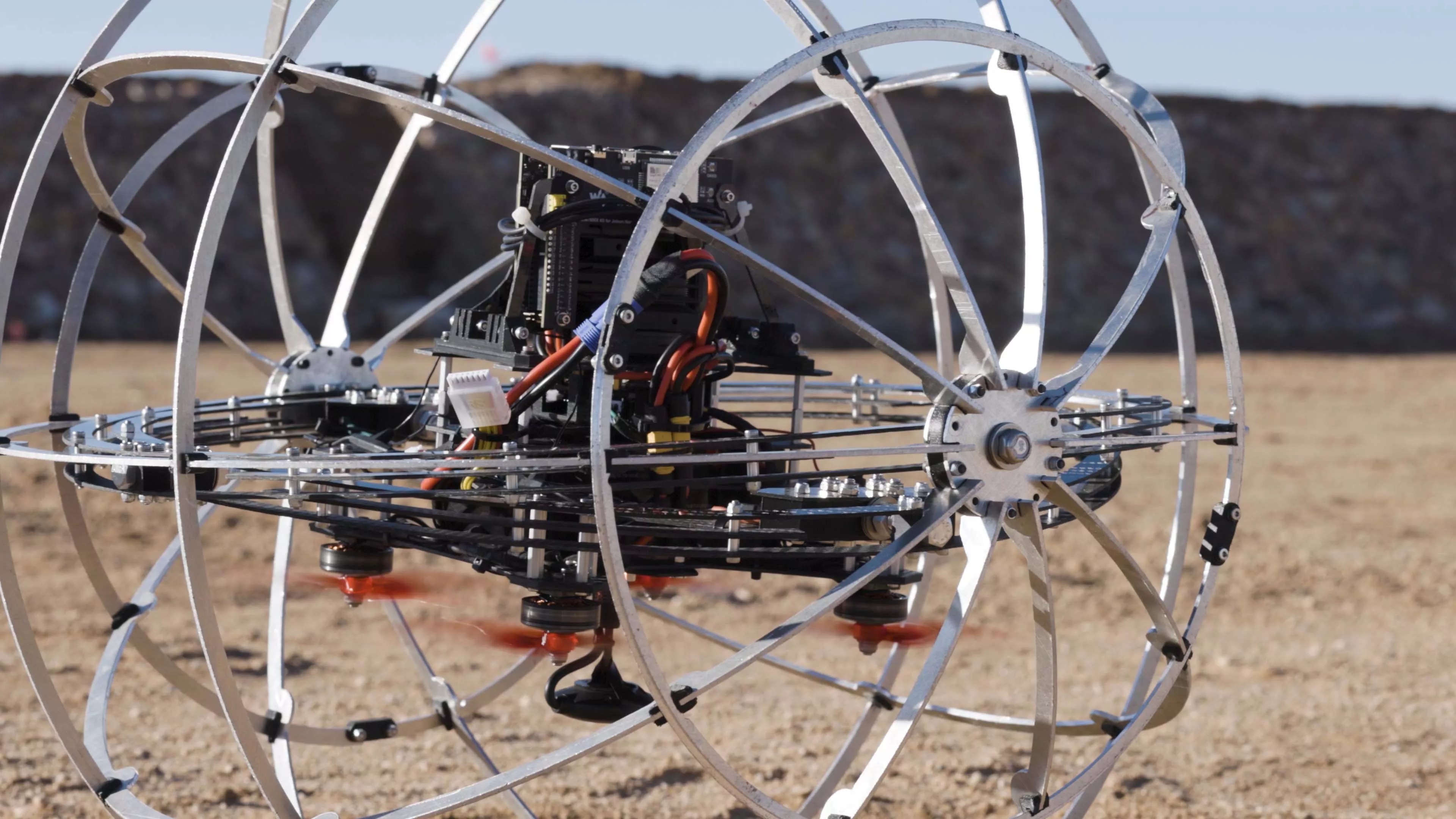
A close-up of the Hybrid Mobility Robot created by Scottsdale-based company Revolute Robotics.
Revolute Robotics
Hybrid Mobility Robot
Picture an aerial drone trapped inside one of those ball-shaped Atlaspheres from “American Gladiators,” and you’ve got the Hybrid Mobility Robot – an all-terrain automaton engineered by Scottsdale-based startup Revolute Robotics. Equal parts rover, drone and metallic hamster ball, the robot is designed for inspection, surveillance and search-and-rescue in hostile and cramped environments (read: collapsed tunnels, condemned buildings or somewhere deep in enemy territory).
The coolest part: It can also navigate any surface and transform into flight mode at the flip of a joystick.
The brainchild of Revolute co-founders Collin Taylor, a robotics industry veteran, and Sahand Sabet, an engineer who previously worked at JPL, the HMR is aimed at saving lives.
“Our primary motivation is keeping humans out of harm’s way,” Taylor told Wired in 2023.
Taylor tells Phoenix New Times the company, which was invited to showcase the HMR at Amazon’s re:MARS conference last year, is now preparing to deploy the robot for pilot testing and collecting and validating data ahead of building and releasing the final product.
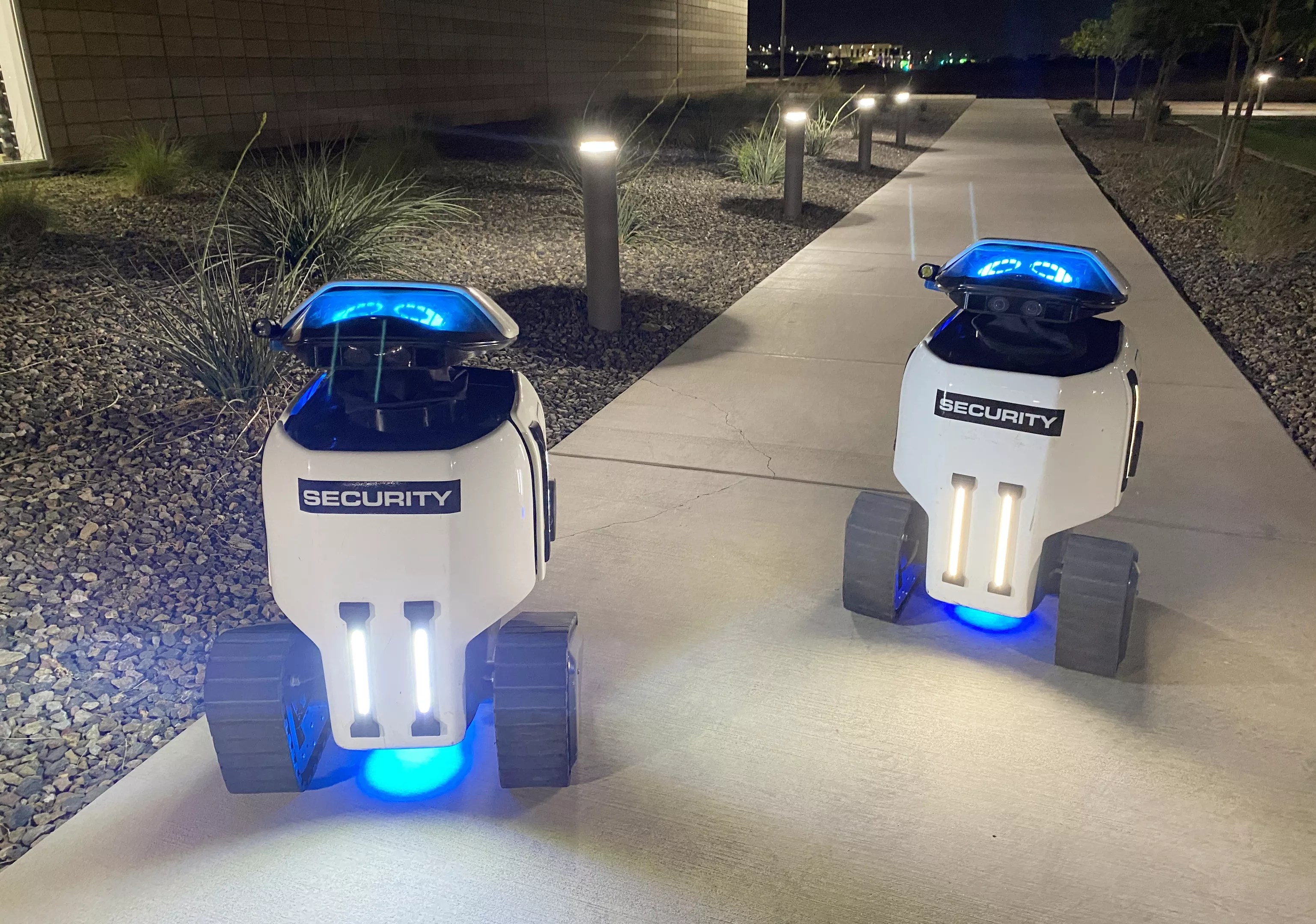
A pair of Dax robots patrolling the IDEA Tempe Campus.
Benjamin Leatherman
Dax robots
Despite what “RoboCop” might’ve led you to believe, the future of AI-powered security isn’t a tyrannical killbot like ED-209. (At least not until our current timeline skews even darker.) Instead, it’s more friendly-faced machines like the Dax robot: compact, wheeled and more like a Disney-esque sidekick than a dystopian enforcer.
Miriam Sullivan, marketing director for Daxbot, says that was baked into the company’s robots from the beginning. “The idea behind Dax was, more or less, that robots are going to be in the future and we have some ability to affect that,” she says. “It’s the direction we want to see that going instead of something that’s threatening or unpleasant to have in people’s public spaces.”
When describing the design of the Dax robot, Sullivan unintentionally echoes the sci-fi novel “The Hitchhiker’s Guide to the Galaxy” and its description of robots as “your plastic pal who’s fun to be with.”
Sullivan says Daxbot modeled some of its robot’s behaviors – heart eyes, head tilts – after the ways dogs interact with people.
Some of its moves are autonomous responses, while others are triggered by human operators at Daxbot’s headquarters in Oregon.
“Operators take over when there’s higher decisions to be made, but that’s not necessarily an operator. It also does some level of human-robot interaction just on its own,” Sullivan says. “If it’s answering higher-level questions, it’s probably an operator.”
As for comparisons to WALL-E or any other Pixar character, she says they’re unintentional (despite the Daxbot website describing a “movie-type robot”).
Like EVE of “WALL-E” fame, the Dax robot can flip from friendly to serious in a heartbeat. Beyond its cutesy encounters with passers-by, its primary function is to “deter, detect (and) delay.” When it encounters disturbances, security companies it partners with in each city, like Transcend Security Solutions in the Valley, see a live feed of what Dax is seeing and can respond.
“The idea is they’re there, they’re monitoring situations, they’re escalating it when need be (and) security will arrive if they need to,” Sullivan says. “But they’re not making public (places) unpleasant for people to be in.”
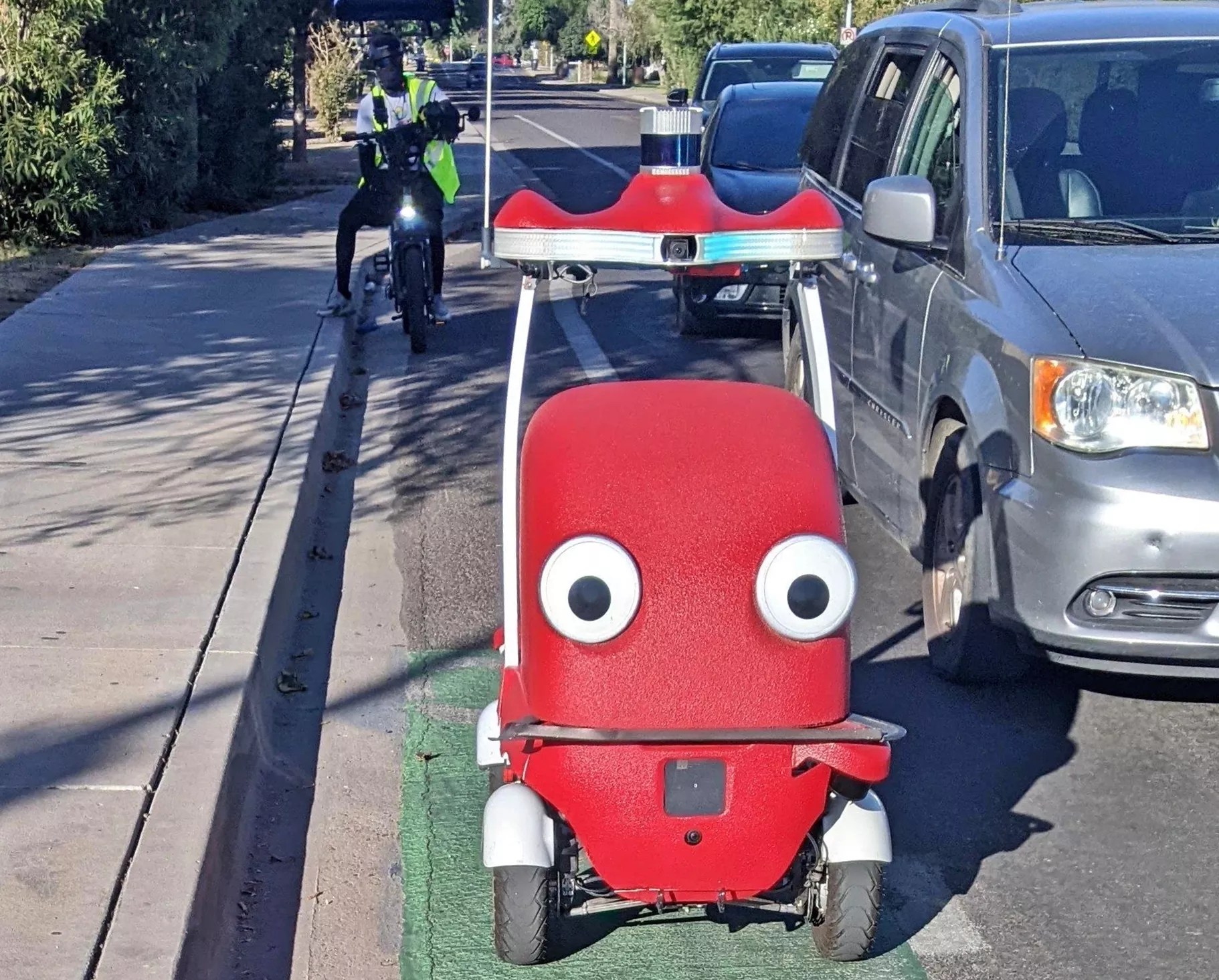
A delivery robot being tested by DoorDash in Mesa and Tempe.
Scott Muller
DashMart delivery robots
When DoorDash’s delivery bot started cruising East Valley streets last year, curious residents lit up social media. (You would, too, after encountering a googly-eyed mashup of a Vespa and a baby buggy roaming about.) “What kind of robot is this?” one local Redditor asked after spotting the crimson-colored contraption.
Turns out they’re part of the testing phase of a delivery service for the company’s DashMart fulfillment platform around Mesa and Tempe.
DoorDash spokesperson Hannah Reilly told Phoenix New Times by email the company is testing out “very small-scale, on-road public deliveries.” As such, the robots are typically trailed by a rider on an e-bike to monitor their progress.
Spot
Spot the robot dog knows more tricks than just how to fetch. These 80-pound mechanical mutts, built by high-profile robotics firm Boston Dynamics, can open doors, drag heavy objects and assist law enforcement in locating explosive devices or keeping tabs on high-risk situations.
The Phoenix Police Department snagged one last year. The Arizona Department of Public Safety picked up a pair. The Arizona Republic reported that DPS shelled out a cool $235,949 for its two high-tech hounds, which will be used by the department’s SWAT teams in the Valley and Tucson.
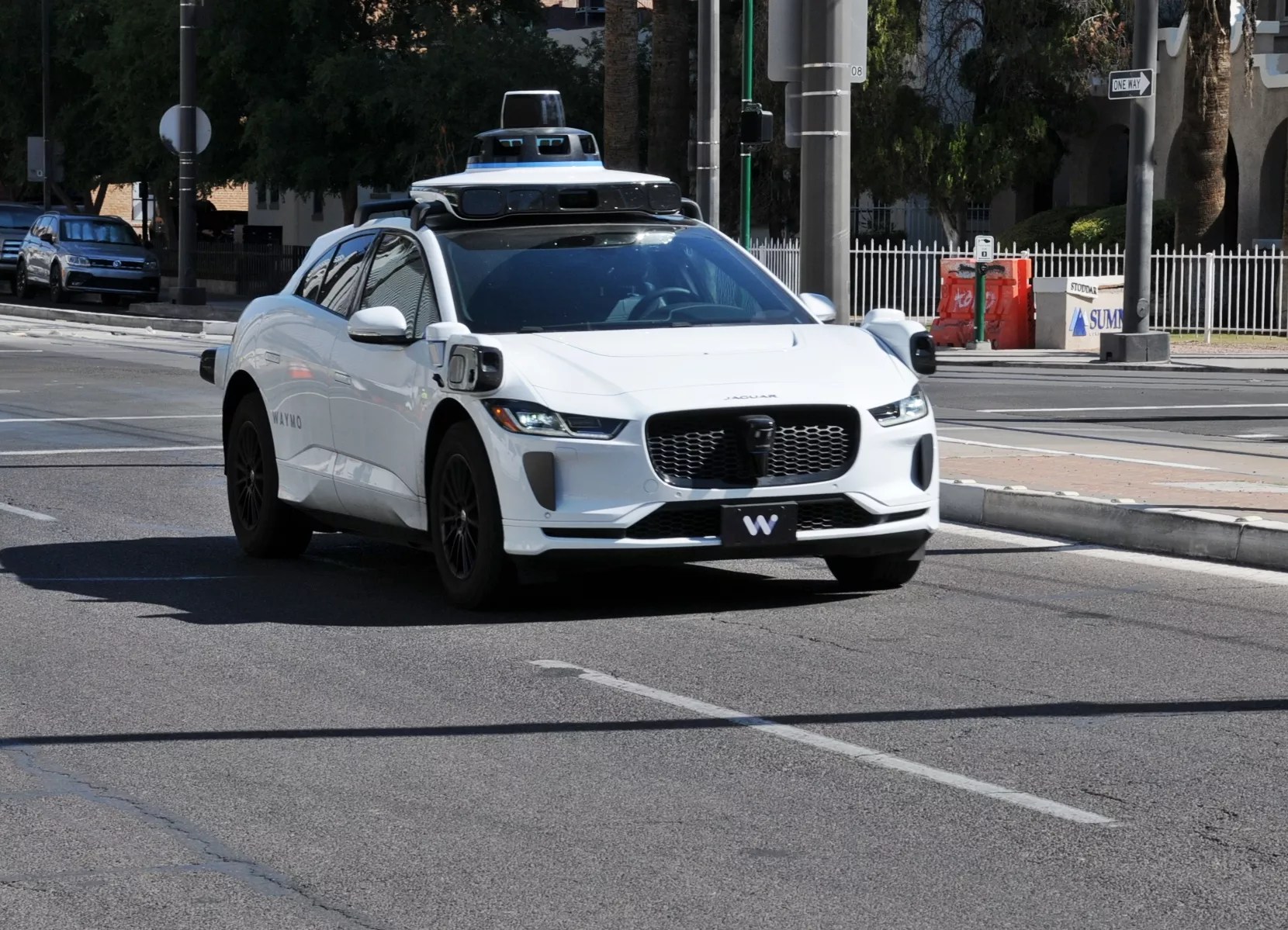
A Waymo spotted along First Avenue in downtown Phoenix.
Benjamin Leatherman
Waymo
Waymos are inescapable in metro Phoenix. With their sensor-laden exteriors, these AirPod-white autonomous vehicles are a frequent sight navigating Valley roads or idling on side streets waiting for a
passenger to summon them.
Since launching the nation’s first driverless taxi service in the East Valley four years ago, the Alphabet-owned Waymo has grown its service area to more than 315 square miles, the largest autonomous ride-hailing territory in the country. Waymo vehicles prowl almost every corner of the Valley, including Phoenix Sky Harbor International Airport – the only airport in the world offering robotaxis. Once the company is satisfied the cars can handle Phoenix’s version of “Mad Max,” you’ll see them on freeways.
Waymo has hit some bumps along the way. Its cars have been known to drive in circles or collide with a telephone pole. The latter led to a voluntary recall of their fleet. With more than 150,000 weekly riders across its operating cities, Waymo’s growing presence in Phoenix has led locals to joke about “calling a robot” instead of “hailing a cab.”
Will Waymos replace human-powered ride-sharing services? Probably not completely, says Kane. “There will always be those people who want a human driver behind the wheel of whatever car they’re in,” he says. And yet there’s also something to be said for riding in the back seat, watching a steering wheel turn seemingly of its own volition.